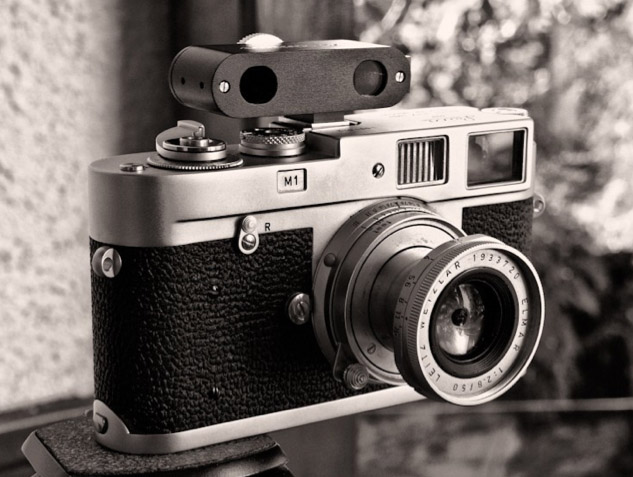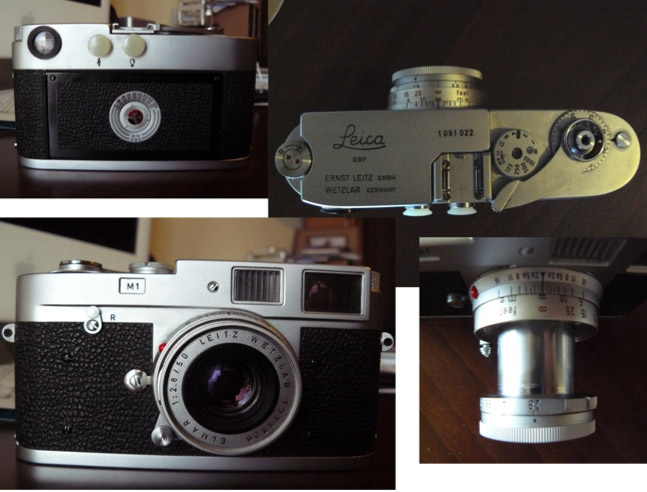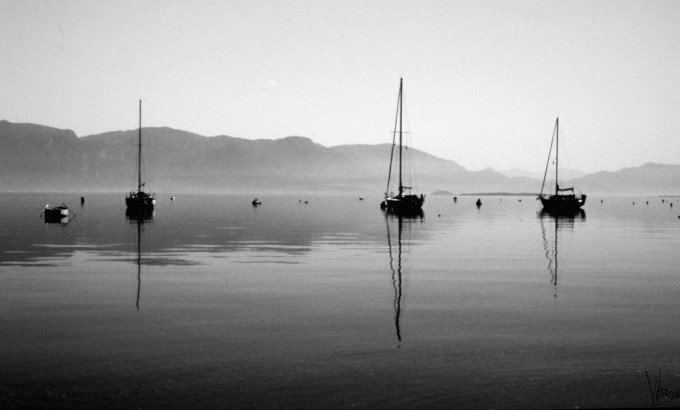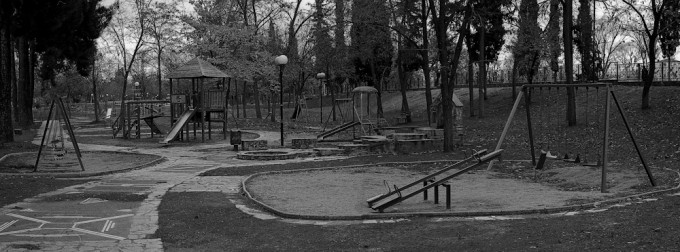The Forgotten Leica…The M1
By Konstantinos Besios
The good old, forgotten Leica M1… a camera that never draws the attention like the legendary M3, M4 and M6. A few years ago I took of a dusty drawer the Leica M1 which my father had bought back in the sixties. It came with the Elmar 50mm f2.8 collapsible lens, both in spectacular chrome.
The camera was like brand new, and it should be since no more than a couple of rolls were shot with it. My father’s interest in photography is the usual family snapshots and a few pictures of travels. The Leica M1 was cheap (for a Leica that is, it was the cheapest M) but for a reason.
It was designed to be an affordable general purpose camera or to use with microscopes and the Visoflex system. For that reason the camera had no rangefinder and no meter. The lack of the meter was no great deal (after all the M6 was the first M to introduce a meter), but a rangefinderless M ? Well, there goes precise focus !!
That kind of simplicity made it hard for anyone to shoot with this camera. You had to use zone focus and use an external meter or use the Sunny 16 rule. Now, there were many cameras in that era that had the same specifications but the M3 and M2 was naturally a better choice.
The M1’s viewfinder has permanent framelines for the 35 and 50 focal lengths (both popular for the usual Leica shooter). The rangefinder window is covered with a metal plate with the M1 logo. I’ve heard in the past that there was an option to add the rangefinder but I didn’t find any more info about it. The wind lever is just like the M3 and M2, and the film loading is done the hard way(the spool way). Its kinda slow and frustrating but after a while you get used to it.
There are really no other differences from the earlier M3 and M2 Leica models. The M1 is a genuine Leica with the same high quality as all other M’s. Now, is it worth to invest in this camera?
Well, I would say no. The prices of the M1 are around the same with the M3 and M2, the fact that the there were only 9500 M1’s made (1959-1964), it kinda makes them a collective camera (it’s more valuable to collectors who want to have the full M line than an amateur photographer). Of course for those few who own one it could be an excellent body to use with wide angle lenses like the 21mm and 15mm where the enormous depth of field makes it easy to use. I’ve shot a lot of rolls with the M1, I have to admit that for street photography is slow, but for those situations when speed is not important it gets good use. The collapsible Elmar 50 f2.8 that came with the camera is an excellent lens with that distinctive vintage look and is used often on my M6.
So, that’s the story about the Leica M1, I think despite the fact that it is the least mentioned Leica M, it deserves a place in the 50 year history of the legendary M series.
English is not my native language so please excuse any mistakes in the text. You can visit my blog HERE.









I maust say.. the m1 has an automatic paralax corection as the lens focuses nearer. The viewfinder is very bright too.
Where can I find a rangefinder like the one in the picture, and what’s the minimum measur8ng distance?
It is a regrettable fact that the MD/MDa/MD-2 prices are starting to approach the level of M3/2. However, they are still an excellent buy. My experience, of having a pair of MDa bodies is that the condition is generally far better than the M3/2, indicating less wear and tear so possibly had a much easier life.
My pair are used with a 3.5cm F3.5 Summaron and the Leitz 3.5cm viewfinder.
Together with a Weston Master V and Invercone, this is my travel outfit. I carry all this in a Billingham for Leica Combination M bag. One of the strengths of these viewfinderless/rangefinderless cameras is the absence of the parts most likely to be damaged or go out of line caused by travel or shock. So the camera consists of shutter and wind on/rewind mechanism. When in use, if my camera film runs out, it’s less than a minute to exchange lens and finder with the body cap of the spare body in my bag. Both bodies are equipped with straps to save time. TIP: if travelling by plane, leave the films out of your bodies, it’s easier for the security staff to examine your equipment especially if yo assist them by opening the camera up and removing lens and body cap.
It’s a rangefinder. But one that isn’t coupled to the lens. You have to read off the distance and set the lens to that value.
Interesting, I’ve often wondered about the M1. One small error though: the first of the M series to get a meter was the M5, not the M6. I have an M5 and love it.
what is the attachment at the top?
Got one that my uncle left my dad with it leather casing make me offer I’m in South Africa
Chris, Oct 4 2013, never mind it’s worth, get out there and use it. I do not exaggerate when I say that it will change your life! It will give your life a new meaning, even when you do not have it with you. In 1985 I bought my first Leica – a 111 made in 1935. It came with a 3.5cm f3.5 Summaron and top-mounted 35 finder SBLOO. Soon I took the SBLOO off and now use it on my MDa. I began to use the 50mm built-in finder with the 35 lens, knowing I would get more on the neg than I could see. The Summaron is quite flat and the camera slides into jeans pocket to walk around with. I have practiced the technique of spotting a shot, pulling the camera out, up to my eye and click. The camera goes back into my pocket all in one smooth seamless movement. Then I move on. Never been confronted or stopped by police, security guards etc. I still have my 111 and used up a roll of XP2 yesterday. Into process tomorrow. By the way, if you only have access to high street labs, use XP2 for mono. It’s C41 process like colour films. I have the negs scanned to disc so, my 1935 Leica becomes a digital camera and I don’t have to learn about pixels (alive or dead), RAW, JPEG, setting the White balance and variou menus. I only use a menu if I go into a restaurant I have not used before. Some plastic digital SLRs have 15 buttons on the back alone. I have 1 button on the 111. All I need.
The M1 was the first of the quirky M models. The M1 was followed by the MD in 1965 and the MDa in 1967 and the MD2 in 1977. These three comers do not have a viewfinder at all. I have and use all three (I cannot afford to collect all the Leica M series cameras so I have made a mini-collection of the MD series.)
The MD has been coupled to a Visoflex 2 and a 280mm Telyt and is used at cricket matches. The MDa has a 35mm lens and a 35mm top-mounted viewfinder and is used for general and street photography.
The MD2 ( blact and made in Canada) has a 21mm f3.4 Super-Angulon, for the most dramatic photography ever!
DAO!!
This sums up what photography is for me. It’s about thought, time and learning to use what we have instead of chasing the latest thing. Your results are beautiful and a credit to the art. Thank you.
My grandfather left me a Leica M1 and I wondered about its value… Can you give me an idea ?
Thanks for the delightful article Konstantinos. I always wondered what the “missing” M1 was so I’m pleased to have found out. Your images are lovely.
Great shots! Love the 1st one.
The second one is as good as it gets from just about any camera. Just … wow. Take me there!
I’d like to thank everyone for your comments, I really appreciate it ! One more addition, the item mounted on the M1’s hot shoe is an external rangefinder (as most of you have probably guessed). That particular one was made by Fotoman and it really helps at those times when precise focus is needed.
and thats, is why film is amazing. As long as you know what you are doing, it will always take a great picture, on just about any camera, there is truly no excuse with film.
Not only are the photos amazing, but who ever would of thought back then that a camera from 1960ish would be taking such amazing photos in the year 2010,
Thanks for sharing.
Definitly seems like it would be a great option for those using lenses so wide that that focus no longer matters much, like the ultra ultra wide voight lenses.
Great article, great pictures! Thanks for sharing 🙂
Beautiful pictures!
1st shot is “Holy Animal” !
Thanks for the great article and for bringing back some focus to film to this great site! I’m waiting for my M3 to be delivered in the next few days and the waiting is killing me!! This really helped!! Great photos also! Esp. love #3!
Thanks!
Anders
I didn’t realize the M1 was rangefinder-less, very interesting. It has a very similar look to the M2, which is a great camera as well. Nice article, nice to read about a camera you don’t hear too much about.
That was beautiful!
Really niece piece, thanks for your efforts! 🙂
Max, you are right about the M5, that was the first M with a meter (it seems like the M5 still is the outcast in the M series and I always forget about it).
Steve, thank you for publishing my article !!
Great post! One correction, the M5 was the first M camera to have built in metering… not the M6.
Looking forward to more articles from you!
Yes, Konstantinos! It certainly deserves its spot…just like the M5 (still the best meter of any M) 🙂
Love that Sensia shot above.
Great post, thanks! Good to have some info and those sample pictures are very good!
One word: amazing!